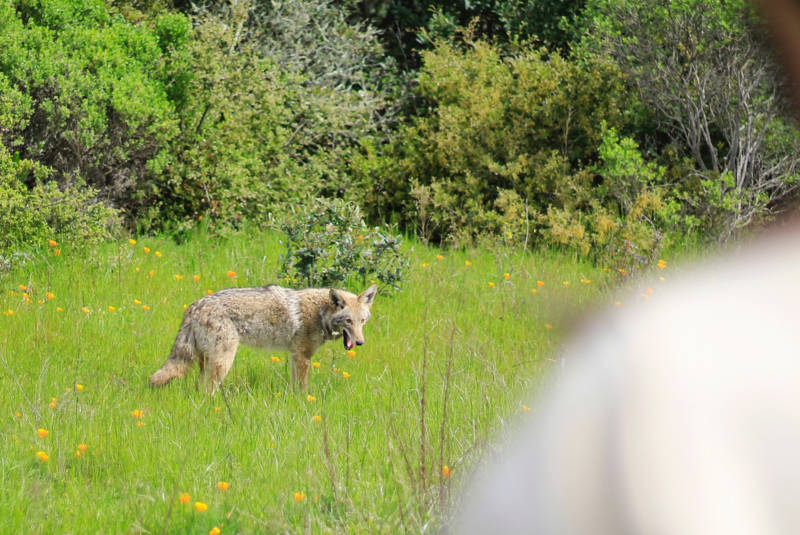How many coyotes live in the Presidio?
When Mike Sun, aka Coyote Mike, posed that question last year to a group of San Francisco preschoolers, he received several blurted replies.

How many coyotes live in the Presidio?
When Mike Sun, aka Coyote Mike, posed that question last year to a group of San Francisco preschoolers, he received several blurted replies.
“Twenty-eight,” said one tot.
“A million,” guessed another.
Close enough. The correct answer was six. Today there are at least four fully grown coyotes and an unknown number of April-born pups.
Sun is an environmental education specialist for the Presidio Trust, and he was talking to his young audience as part of a public outreach program about wildlife in the Presidio of San Francisco national park, about 1,500 acres on the northern edge of the San Francisco Peninsula, near the Golden Gate Bridge. The land, full of wooded areas and historical attractions, housed a U.S. Army post from 1847 to 1994. It’s now managed by the trust, along with the National Park Service and the Golden Gate National Parks Conservancy.
The coyotes have sometimes surprised humans, who also like to use the park. Kay Firth-Butterfield, strolling along Arguello Gate on the south end, once ran into a coyote who started toward her, startling her dog.
“I didn’t think it was threatening, it was just walking towards us,” she said, “but the German shepherd was scared stiff and took off running.”
Conflicts between dogs and coyotes arise when canines get too close to coyote dens during the spring and summer pupping season, or when off-leash dogs give chase, said Presidio Trust Wildlife Ecologist Jonathan Young. In recent years, San Francisco has seen several coyote attacks on dogs, some of them reportedly fatal. Bay Area coyotes have also been known to kill cats.
These encounters make public education critical, says Young.
“Fear usually stems from lack of understanding,” he said. “If we can educate the public on what we know, we can ease the fear.”
Recolonizing San Francisco
Coyotes in the Presidio were pushed into local extinction by San Francisco’s growing population, and were last seen in the mid-1900s, according to San Francisco’s Department of the Environment. But they returned to the park in 2002, following a change in human attitudes.
“Social acceptance and approval of firearms and hunting have declined while animal rights views have increased within urban/suburban areas,” reads a coyote FAQ from the Presidio Trust. “These social changes were reflected in the 1974 ending of state/federal sponsored mammalian bounties in California. With the reduction/removal of these urban pressures, these animals began to move back into surrounding urban areas, eventually recolonizing San Francisco in the early 2000s.”
The city’s view is that coyotes help keep the rodent population down. In 2016, the Presidio Trust started a coyote monitoring program, which involves tagging and collaring the animals with temporary GPS devices. Sixteen coyotes have been tagged to date. Not including the offspring born this year, 15 pups have sprung from three different litters.
“Nine of those 15 pups have since dispersed from the Presidio, and we’ve tracked their journeys as they try to find their own territory elsewhere,” the trust says on its website. “Many of these animals have not survived the harsh realities of urban traffic.” (See this map of one young coyote’s journey from the Presidio to San Jose before being fatally hit by a car on Interstate 280.)
Coyotes, which are highly adaptable, are also regularly spotted in some of the city’s other open spaces, like Golden Gate Park, Buena Vista Park, and Lands End.
So now, humans are the ones who have to adapt.
“The current population is not used to coyotes as a part of the urban environment,” said Clay Harrell, a senior communications executive at the Presidio Trust. “Many people see their presence as a threat to public safety and their pets, and want authorities to remove the threat.”
Lots of people ask why the Presidio wildlife team hasn’t relocated the park’s coyotes. According to park ecologists, transplanting them would be pointless.
“If a coyote is removed from its local territory, another will quickly take its place,” the trust’s FAQ says. “In other words, there is an endless supply surrounding the greater Bay Area.”
Since coyotes are now considered to be a permanent part of the Presidio’s ecosystem, officials are fostering coexistence through workshops, social media, incident hotlines and signage.
“The more the public knows about expected coyote behavior and how human habits can affect coyote behavior, the more we minimize potential conflicts,” said Harrell.
Sun puts it this way:
“Managing coyotes is impossible, human management is more possible.”
To learn more about how we use your information, please read our privacy policy.